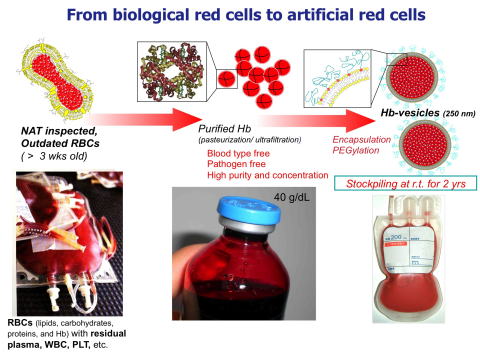RESEARCH
Artificial red cells for clinical applications

1. Background
Blood transfusion systems have greatly benefited human health and welfare. Nevertheless, some problems remain: possibility of infection, blood type mismatching, immunological response, and short shelf life which is insufficient for stockpiling for emergency situation. Realization of artificial red cells (artificial O2 carriers) is expected to solve such problems. During the long history of development of hemoglobin (Hb)-based O2 carriers, many side effects of Hb molecules have become apparent. They imply the physiological importance of the cellular structure of red blood cells (RBCs). We have developed Hb-vesicles (HbV) as artificial O2 carriers that encapsulate concentrated Hb solution with a thin lipid membrane. The in vivo safety and efficacy of HbV have been studied extensively (CCM 2004; JPET 2004; Transfusion 2006; JIM 2008; JBC 2008). The results illustrate the potential of HbV as a transfusion alternative and promise its use for other clinical applications that remain unattainable using RBC transfusion (Sci Rep 2015; Transplantation 2015; Plast Reconstr Surg (in press)). Our research on HbV has been supported by Ministry of Health, Labour and Welfare, and now by Japan Agency for Medical Research and Development (AMED).
On the other hand, it is widely accepted that trace amounts CO and NO, known as toxic gaseous molecules, are endogenously produced for vasorelaxation, cytoprotection, etc. Administrations of exogenous NO and CO are clinically approved. Because Hb binds not only O2, but also CO, it is expected that HbV might be utilized to deliver such gases for pharmacological effects (Shock 2009, Biomaterials 2014, J Control Release 2016).
2. Aims and details of the research
The aim of our research is to establish “gas bioengineering”, new methods to administer and regulate gaseous molecules into pathological conditions and ex vivo tissue engineering using artificial red cells for versatile clinical applications.
A) To find new clinical applications of HbV and other HBOCs as an artificial O2 carrier (such as a perfusate for organ transplant or three-dimensional tissue engineering) by utilizing the unique physicochemical properties such as small particle size (250 nm), and adjustable O2 affinity and rheological properties for tailor-made artificial red cells.
B) To clarify the pharmacological effect of HbV as CO carriers in synergy with O2 carrying capacity, and its mechanism in ischemia-reperfusion injury and other pathological models, where reactive oxygen species are produced or peripheral blood flow is deteriorated. Additional non-enzymatic reaction mechanisms will be established in HbV to eliminate superoxide and peroxynitrite, and to reduce metHb. Nitrite reductase- like activity to produce NO and superoxide dismutase-like activity will also be interesting to improve the pharmacological effects
C) To promote HbV as a transfusion alternative all over the world, where the present transfusion system is insufficient, or where natural disasters or new pathogens threaten the present medical system.
D) Application of HbV for veterinary use.
Our academic research consortium includes researchers of domestic and overseas research institutes, such as Asahikawa Medical Univ., Sojo Univ., National Defense Medical College, Tokai Univ., Kumamoto Univ., Waseda Univ., Keio Univ., etc. in Japan, and UCSD, MGH, Univ. of Berne, National Univ. of Singapore, etc.
3. Experience artificial red cells from A to Z
All the equipment necessary to prepare tailor-made HbV and HBOCs for in vivo use is installed in our facility. After the physicochemical characterization and adjustment of the HbV and HBOCs suspension, it will be intravenously injected into animal models or utilized for other purposes such as a perfusate in tissue engineering. We will provide unique opportunity to study from the preparation of HbV and HBOCs to the efficacy and safety evaluation in animal experiments. The physicochemical properties of HbV can be modified and optimized anyhow because HbV is a molecular assembly.
I have worked on this subject since 1991. The research field expands from polymer science to bioengineering, biochemistry, chemical engineering, biorheology, hematology, critical care medicine, pharmacolody, biology, tissue engineering, etc. We welcome you of any fields, an active researcher from domestic and overseas countries, to join our meaningful and challenging research project that will obviously benefit medical technology in the future.
Banners
SAKAI Laboratory
Postal Code 634-0813
Shijo-cho 88, Kashihara,
Nara, Japan